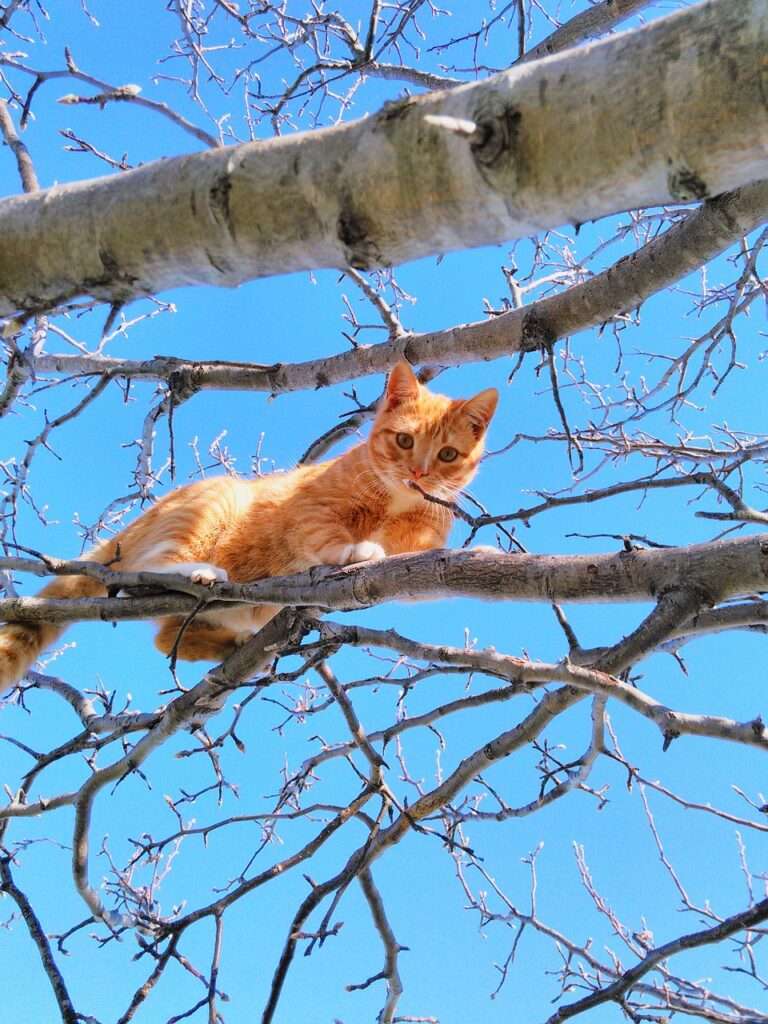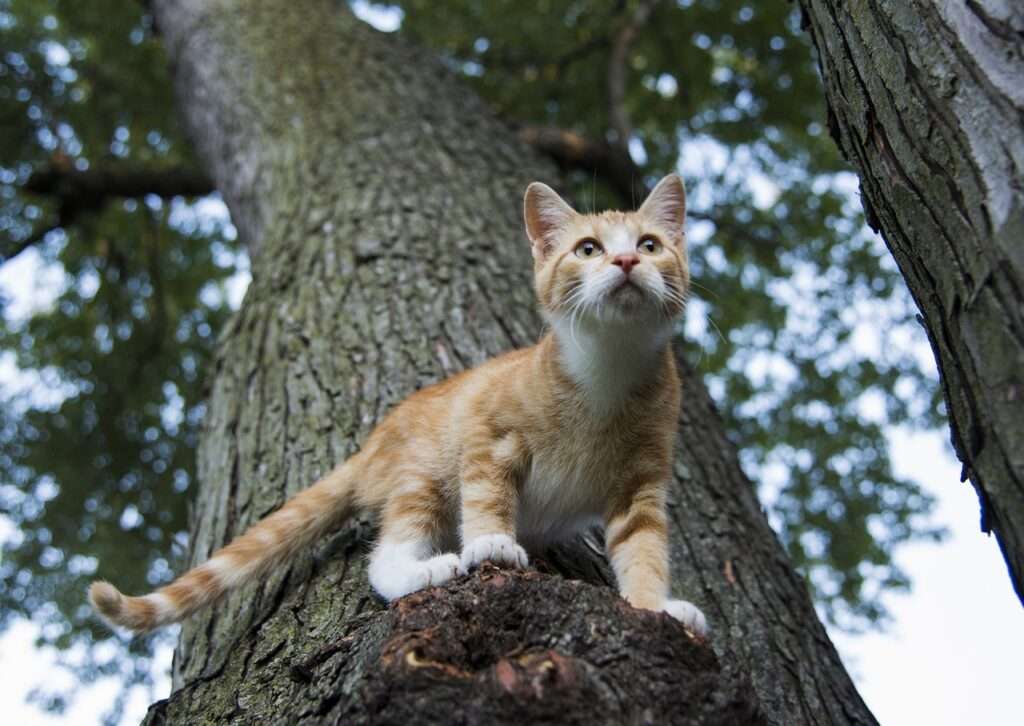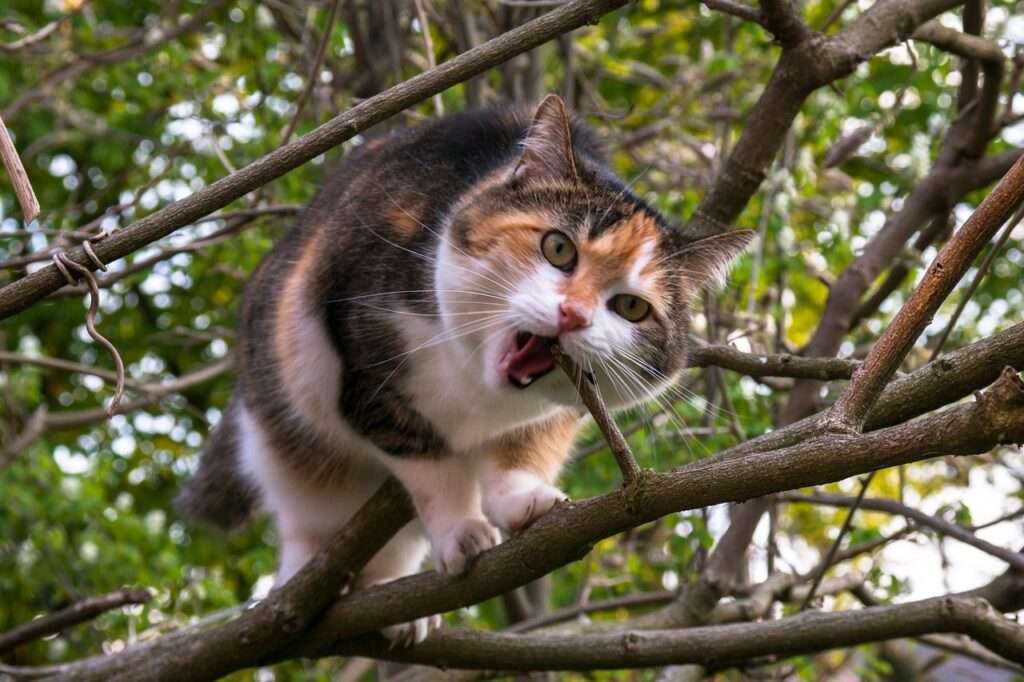How to Get a Cat Out of a Tree: Expert Techniques Revealed!
As devoted pet owners, we know that sinking feeling of watching our feline friends perched high up in a tree, seemingly out of reach. Cats, with their innate curiosity and agile nature, can find themselves in precarious situations that require our help.
At BarkLikeMeow, we understand the importance of keeping our beloved companions safe and secure, which is why we’ve crafted this indispensable guide to help you navigate the challenging task of rescuing your cat from the treetop. Prepare to become a hero and bring your adventurous kitty back to solid ground with confidence and peace of mind.
Assessing the Situation

When you discover your cat perched high up in a tree, it’s natural to feel a sense of panic. However, it’s crucial to remain calm and composed, as your furry friend can pick up on your emotions. Start by reassuring yourself that with the right techniques and a level-headed approach, the rescue can be successful.
Next, gather as much information as possible about your cat. Consider their breed, age, and size, as these factors can influence the best approach for rescuing them. Additionally, familiarize yourself with your cat’s behavioral traits and how they typically react to stressful situations. This knowledge will help you tailor your rescue efforts to suit your cat’s specific needs.
Evaluating the tree is also an essential step in the assessment process. Take a moment to assess the height and stability of the tree, as well as the surrounding environment. Look out for any potential hazards or obstacles that may complicate the rescue mission. By carefully evaluating the situation, you can better prepare yourself for a safe and effective rescue operation.
Preparation and Equipment
Rescuing a cat stuck in a tree is a task that often requires a collaborative effort. It’s important to reach out to neighbors, friends, or even consider seeking professional help to assemble a capable rescue team, if necessary. Working together with a team not only increases safety but also enhances the chances of a successful rescue mission. Cooperation and coordination among team members are crucial throughout the operation. Your safety should always be a top priority during a cat rescue mission.
Make sure to wear appropriate clothing and protective gear to minimize the risk of injuries. Opt for long sleeves and pants to shield yourself from potential scratches or bites. Consider wearing gloves to provide an extra layer of protection for your hands. Sturdy footwear with good grip is essential for navigating the tree and maintaining balance, ensuring you can move safely and confidently.
Having the right tools and materials on hand is crucial for a smooth and successful rescue operation. Here are some essentials to consider:
- Sturdy Ladder: A stable ladder that reaches the height of the tree is fundamental for accessing the cat. Ensure the ladder is secure and positioned at an appropriate angle to facilitate a safe ascent.
- Ropes and Extension Poles: These tools can be invaluable for reaching and maneuvering the cat. They allow you to extend your reach, offering a safe and controlled way to guide the cat towards safety.
- Carriers: Prepare a secure and comfortable carrier to transport the cat once they are rescued. This provides a confined space where the cat can feel secure during transport.
- Blankets: Soft blankets are essential for creating a cozy and comfortable environment. They can be used to create a perch or platform for the cat to land on, reducing the risk of injury and providing a sense of security.
- Treats: Treats serve as incentives to encourage the cat to come down from the tree or to approach you during the rescue. Have some of their favorite treats on hand to entice them and make the experience less stressful.
By following these guidelines and ensuring you have the necessary equipment, you’ll be well-prepared for a safe and successful cat rescue mission. Remember to prioritize safety, teamwork, and the well-being of the cat throughout the process.
Assessing the Cat’s Behavior

Understanding feline psychology is essential for a successful rescue. Cats have natural instincts and fear responses that can affect their behavior in stressful situations. By familiarizing yourself with these instincts, you can adapt your approach accordingly.
Approaching the cat with a calm and patient demeanor is crucial. Speak softly and avoid sudden movements that may startle or scare the cat further. Building trust is essential, and it’s advisable to let the cat become familiar with your presence before attempting any physical contact.
Pay attention to the cat’s body language as it can provide valuable cues about their emotional state. Signs of anxiety or fear may include flattened ears, dilated pupils, or a low crouched posture. By being observant, you can gauge the cat’s comfort level and adjust your actions accordingly.
Non-Invasive Techniques
When attempting to rescue a cat stuck in a tree, non-invasive techniques should be the first approach. These methods prioritize the cat’s safety and minimize stress. Here are a few strategies to consider:
Enticing the cat with treats or toys can be an effective way to grab their attention and encourage them to come closer to a safe spot. Select high-value treats that your cat finds irresistible, such as their favorite flavor or crunchy texture. Similarly, toys that stimulate their natural instincts, like feathers or laser pointers, can be used to pique their curiosity and lure them towards you.
Soothing sounds or familiar voices can help calm an anxious cat. Consider playing recordings of your own voice or the cat owner’s voice, as the familiarity can provide a sense of comfort. Soft, gentle tones can help alleviate their stress and encourage them to trust you.
Using Climbing Equipment
If non-invasive techniques aren’t successful or the cat remains at a considerable height, it may be necessary to utilize climbing equipment. Before proceeding, ensure you have a stable ladder that reaches the appropriate height of the tree. Safety should always be the top priority.
Position the ladder at an angle that allows for a secure ascent. Make sure the ladder is firmly placed on the ground and against a sturdy part of the tree. Test its stability before climbing to minimize the risk of accidents.
When ascending the tree, exercise caution and maintain your balance. Look for sturdy branches to hold onto and distribute your weight evenly. Take your time and proceed steadily, avoiding sudden movements that may startle the cat or compromise your safety.
Encouraging the Cat to Descend
Creating a comfortable perch for the cat is crucial to encourage their descent from the tree. Use a blanket or a carrier as a safe platform and place it at a reachable and stable location. The familiarity of the blanket or carrier can provide a sense of security to the cat, making them more inclined to move towards it.
As you approach the cat, speak softly and avoid sudden movements. Offer treats or their favorite toys to entice them to come closer to the perch. Patience is key during this process, as some cats may take longer to build up the confidence to make their way down.
Refrain from forcefully pulling or grabbing the cat, as this can cause them to become frightened or defensive. Instead, allow them to make their own way down at their own pace. Your supportive presence and encouragement will help facilitate their descent.
Using Extension Poles or Ropes
In cases where the cat is reluctant to descend or unable to reach the lower branches, extension poles or ropes can be employed. These tools allow you to guide the cat gently and safely towards the ground.
Ensure you have a firm grip on the extension pole or rope and maintain control throughout the process. Slowly guide the cat by applying gentle tugs or steady movements. Avoid jerking or sudden actions that may startle or distress the cat further.
Attach the extension pole or rope to the cat’s body or harness securely. This attachment should be strong enough to provide support but not so tight as to cause discomfort or restrict their movement. Regularly check the tension to ensure it remains appropriate during the descent.
By using extension poles or ropes, you can provide gentle assistance to the cat while maintaining a safe distance. This method allows for a controlled and stress-free rescue operation.
Dealing with Resistant or Aggressive Cats

While most cats respond well to gentle techniques, some may exhibit resistance or aggression during a rescue operation. It is crucial to assess the risks involved and prioritize personal safety when dealing with such situations.
Recognizing signs of aggression or fear is essential in determining the best course of action. If the cat displays aggressive behaviors such as hissing, growling, or swatting, it is important to prioritize your safety and consider seeking professional assistance.
Maintaining personal safety is paramount. Ensure you are wearing appropriate protective gear and have the necessary tools at hand for self-defense if needed. If you feel unsafe or unable to handle the situation, do not hesitate to contact animal control or a local rescue organization. These professionals have the expertise and experience to handle difficult or dangerous rescues.
Post-Rescue Care and Tips
After successfully rescuing your adventurous feline from that towering tree, it’s crucial to provide them with proper post-rescue care and follow these helpful tips to ensure their continued well-being:
- Conduct a Thorough Examination: Take a moment to carefully inspect your cat for any injuries or signs of stress. Look out for wounds, limping, or abnormal behavior. If you notice anything concerning, don’t hesitate to contact your veterinarian for a detailed examination.
- Create a Safe Haven: Give your brave explorer a safe and secure environment to recover from their escapade. Keep them indoors temporarily, allowing them to rest and recuperate. Set up a quiet space with familiar items like their cozy bed or beloved toys, offering a comforting atmosphere that helps them feel secure and at ease.
- Provide Comfort and Support: During their recovery process, your cat will appreciate your comforting presence. Spend quality time with them, offering reassurance and gentle affection. Monitor their behavior and appetite closely, as any changes might indicate potential stress or underlying health issues. Being attentive to their needs will go a long way in helping them bounce back.
- Prevent Future Incidents: Now that you’ve experienced the thrill of the tree rescue, it’s time to think ahead and take measures to prevent similar incidents. Assess your surroundings for any potential hazards that may entice your cat to climb trees again. Consider securing outdoor areas or providing alternative climbing options, such as cat trees or scratching posts, to satisfy their natural instincts in a safer setting.
Remember, your cat’s safety and well-being are of utmost importance. By following these post-rescue care tips, you can ensure that your adventurous feline continues to thrive and explore their world in a secure and joyful manner.
Conclusion
Rescuing a cat stuck in a tree can be a challenging and emotionally charged situation. At BarkLikeMeow, we hope that this comprehensive guide has equipped you with the knowledge and techniques necessary to conduct a safe and successful rescue operation.
Remember, maintaining a calm and composed demeanor is vital throughout the process. Assess the situation, gather the appropriate equipment, and utilize non-invasive techniques to encourage the cat to descend. In more challenging cases, climbing equipment, extension poles, or ropes can provide assistance while prioritizing the cat’s safety.
While your determination and efforts are commendable, always prioritize personal safety. If you encounter a resistant or aggressive cat, seeking professional help is a wise decision. Local animal control or rescue organizations have the expertise and resources to handle challenging situations.
After successfully rescuing your cat, post-rescue care is essential. Assess their well-being, provide a secure environment, and offer comfort and support during their recovery. By implementing preventive measures, you can minimize the chances of future incidents and keep your adventurous feline friend safe.
Frequently Asked Questions
Q: How long can a cat stay stuck in a tree?
A: Cats are natural climbers and can generally find their way down from a tree on their own. However, if your cat appears to be stuck for an extended period, it’s best to take action and facilitate their rescue. The duration can vary depending on factors such as the cat’s age, health, and comfort level in high places.
Q: Can I use a ladder to rescue my cat?
A: Yes, a ladder is one of the primary tools used in cat rescues. Ensure that the ladder is stable and securely positioned against the tree before attempting to climb. Take caution and have someone assist you in holding the ladder steady for added safety.
Q: What if my cat is too high up in the tree for me to reach?
A: If your cat is extremely high up and out of reach, it’s advisable to seek professional help. Contact your local animal control or a tree service company experienced in cat rescues. They have specialized equipment and expertise to handle challenging situations.
Q: How can I coax my cat to come down from the tree?
A: There are several techniques you can try to encourage your cat to descend. Using treats or their favorite toy as a lure can entice them to come closer to the rescue area. Additionally, speaking softly, calling their name, and using reassuring tones can help alleviate their fear and encourage them to come down.
Q: What if my cat becomes aggressive or frightened during the rescue?
A: If your cat displays signs of aggression or extreme fear, it’s important to prioritize your safety. In such cases, it’s best to contact professionals who have experience handling aggressive animals. They can safely handle the situation and ensure the well-being of both you and your cat.
Q: Should I attempt to climb the tree myself to rescue my cat?
A: Climbing a tree to rescue your cat can be dangerous and should only be attempted if you are confident in your climbing abilities and have the necessary equipment. If you are unsure or uncomfortable with climbing, it’s best to seek professional assistance to ensure everyone’s safety.
Q: What if my cat is injured or appears to be in distress while stuck in the tree?
A: If your cat is injured or in distress, it’s crucial to contact a professional veterinarian or animal rescue organization immediately. They have the expertise and resources to handle the situation and provide appropriate medical care for your cat.
Q: Can I use food or treats to lure my cat down from the tree?
A: Yes, using food or treats that your cat finds irresistible can be an effective way to coax them to come down. Place the food or treats near the base of the tree or on a lower branch to encourage them to move closer to the ground.
Q: What should I do if my cat refuses to come down from the tree?
A: If your cat is hesitant or refuses to come down, it’s important not to panic. Give them some time and space, as they may feel more comfortable descending on their own. Monitor the situation closely and consider seeking professional help if necessary.
Q: How can I prevent my cat from getting stuck in a tree in the future?
A: To prevent future tree-climbing mishaps, consider providing your cat with alternative high perches, such as a tall scratching post or a cat tree indoors. Regular play sessions and mental stimulation can also help satisfy their climbing instincts. Additionally, keeping your cat indoors or supervised when outdoors can minimize the risks of tree-related incidents.
Remember, every cat rescue situation is unique, and it’s important to assess the circumstances and prioritize safety. If you have concerns or encounter challenges during the rescue process, don’t hesitate to seek professional assistance. Your cat’s well-being and your own safety are of utmost importance.





